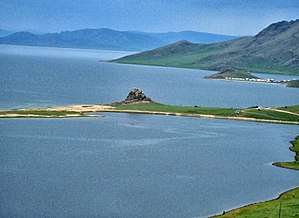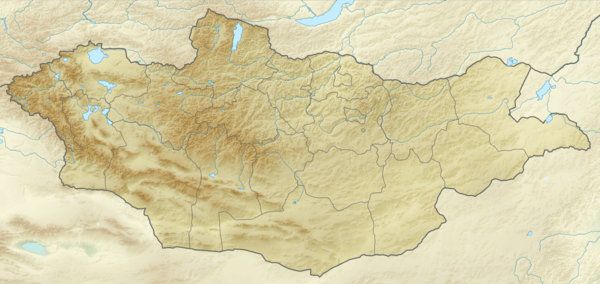Khorgo-Terkhiin Tsagaan Nuur National Park
Khorgo-Terkhiin Tsagaan Nuur National Park (Mongolian: Тэрхийн Цагаан нуур) covers the picturesque Terkhiin Tsagaan Lake and the nearby Khorgo Mountain (a recently extinct volcano) in the north central khangai Mountains of Mongolia. The marshes along the west end of the lake are an important breeding and staging area for birds. The park is located in Tariat District of Arkhangai Province.[1]
| Khorgo-Terkhiin Tsagaan Nuur National Park | |
|---|---|
| Mongolian: Тэрхийн Цагаан нуур | |
IUCN category II (national park) | |
 Terkhijn Tsagaan Lake | |
 Location of Park | |
| Location | Mongolia |
| Coordinates | 48.2°N 99.8°E |
| Area | 773 hectares (1,910 acres; 8 km2; 3 sq mi) |
| Established | 1965 |
| Governing body | Ministry of Environment and Green Development of Mongolia |
Topography
The park is situated in the valley of the Chuluut River and Suman River in the Tarvagatai Range of the Khangai Mountains. Lake Terkhiin Tsagaain is a freshwater, oligotrophic lake in a volcanically-formed valley. The terrain immediately around the lake is hills with steppe and forest steppe vegetation. The lake is about 15 km long. It has a maximum depth of 20 meters, with 40% being less than 2 meters deep.[2]
Khorgo Mountain is about 4 km east of the lake, in the Taryatu-Chulutu valley, a volcanic field. Khorgo experienced a significant eruption in approximately 8,000 BCE.

Climate and ecoregion
The climate of the area is Cold semi-arid climate (Köppen climate classification (BSk)). This climate is characteristic of steppe climates intermediary between desert humid climates, and typically have precipitation is above evapotranspiration. At least one month averages below 0 °C (32 °F).[3][4] Annual precipitation averages 100–100 mm, with 80% of that falling in July and August.[2] The park is in the Selenge-Orkhon forest steppe ecoregion.[5]
Flora and fauna
The fish in the lake are typical northern Eurasian species - cyprinids (Cyprinidae), pike and perch. Birds breeding in the marshes along the lake's edge include Bar-headed goose (Anser indicus), Ruddy shelduck (Tadorna ferruginea), and Red-breasted merganser (Mergus serrator).[2]
See also
References
- "Khorgo-Terkhiin Tsagaan Nuur National Park". Official park Facebook page. Retrieved April 25, 2020.
- "Terhiyn Tsagaan Nuur". Ramsar Sites Information Service. Retrieved 25 April 2020.
- Kottek, M., J. Grieser, C. Beck, B. Rudolf, and F. Rubel, 2006. "World Map of Koppen-Geiger Climate Classification Updated" (PDF). Gebrüder Borntraeger 2006. Retrieved September 14, 2019.CS1 maint: multiple names: authors list (link)
- "Dataset - Koppen climate classifications". World Bank. Retrieved September 14, 2019.
- "Map of Ecoregions 2017". Resolve, using WWF data. Retrieved September 14, 2019.